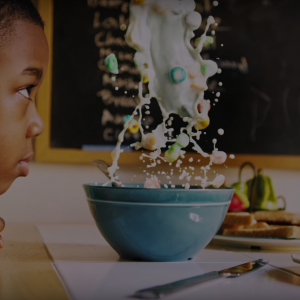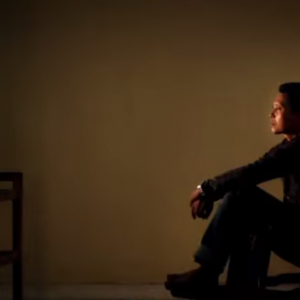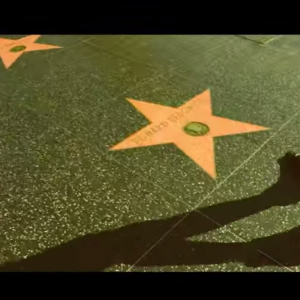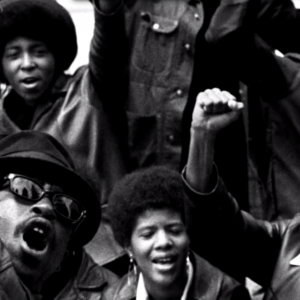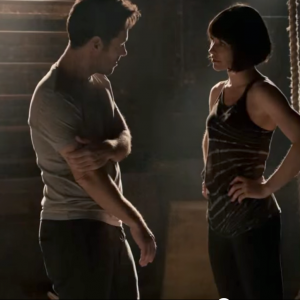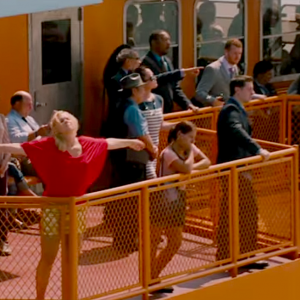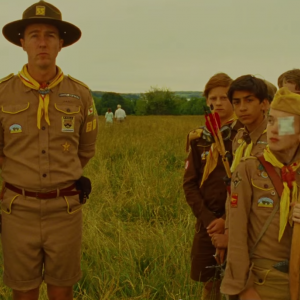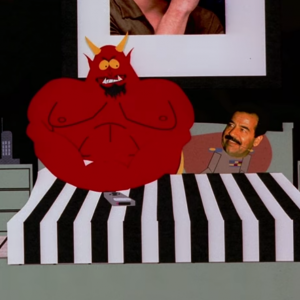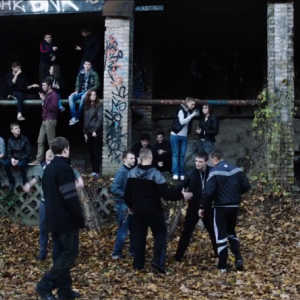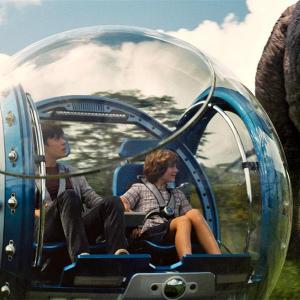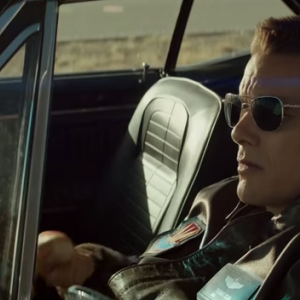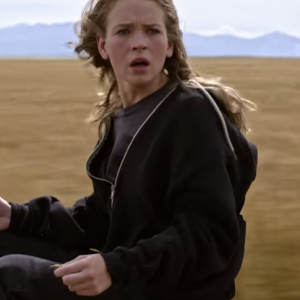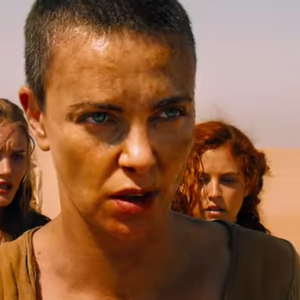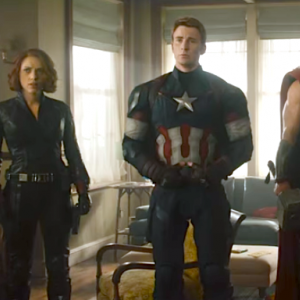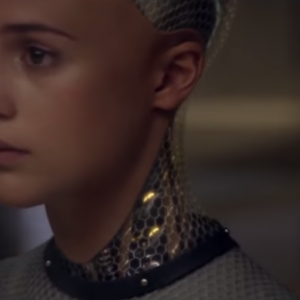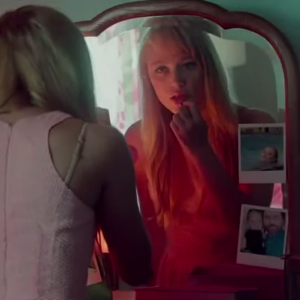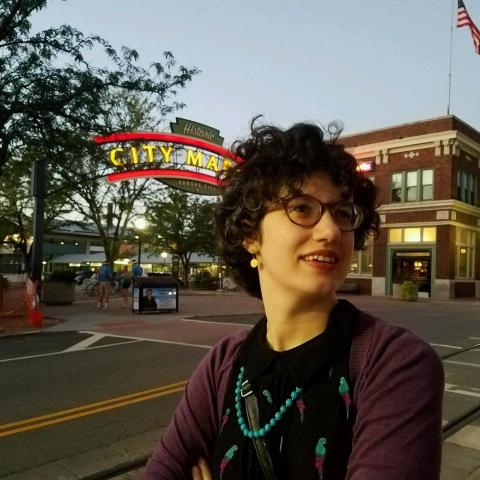
Abby Olcese (@abbyolcese) has been many things — a campus ministry leader at the University of Kansas, an English teacher in Prague, and an advertising assistant at Sojourners. These days, she’s a freelance writer based in Kansas.
Raised on a diet of Narnia, Bob Dylan records and Terry Gilliam movies, Abby is drawn to the weird, the nerdy, and the profoundly artsy corners of popular culture. She loves sharing this knowledge with others by writing about interesting new releases as well as lesser-known gems.
Abby is also passionate about the intersection of faith, social responsibility, and culture. She believes in the power of art to spark important conversations, inspire social change, and help people to better understand life in the kingdom of God.
When she’s not watching movies or writing things down, you can usually find Abby reading comic books or perusing the selection at her local record store.
Posts By This Author
This New Superhero Comic Stars the Superhero's Single Working Mom
However, even among multi-tasking, family-oriented comic book stars, Nicole, the star of the new independently published series Raising Dion, is unique. A widowed, black single mother, Nicole has no superpowers of her own. Her son, Dion, is the one with emerging superhuman abilities.
The comic, created and written by Dennis Liu, aims to show readers what it’s like to raise someone who may become the next great superhero...or the most terrifying supervillain the world has ever seen.
The first issue of Liu’s new comic (available as a free download from the author’s website) introduces readers to Nicole and Dion, and tells the story of how Nicole met her husband Mark, Dion’s father. One night, on a camping trip, Mark witnesses a strange phenomenon in the sky, and is struck by a powerful flash of light. Whatever side effects Mark picks up from his experience, he passes on to his son when Dion is conceived.
When the Enemy Lives Next Door
On a macro level, however, The Look of Silence is equally important in its examinations of evil, guilt, consequence, and forgiveness. It’s a horrifying document of the cruelty humans are capable of, and the ways we try to justify our sins, especially those that are very clearly unjustified. It’s also an incredible example of the courage and grace to seek reconciliation — which, through Adi’s example, Oppenheimer shows we’re equally capable of. The Look of Silence is required viewing, equal parts frightening and beautiful, much like the landscape it portrays.
Why the Transgender Representation in ‘Tangerine’ is Important
When a movie examines a group of people whose stories are only starting to gain mainstream attention — and does it with honesty and compassion — it’s important to pay attention. Director Sean Baker’s wickedly funny and stylish film Tangerine dives deep into the transgender community in Los Angeles in a way that explores the strengths, vulnerabilities, and deep needs of its characters. In other words, it portrays them as real people, not as caricatures — or Oscar-friendly approximations played by a cisgendered actor in drag.
How Much Do You Know About the Black Panthers?
We learned about sit-ins, bus boycotts, Martin Luther King, and Malcolm X. But when it came to the Black Panthers, I was taught virtually nothing. I can vaguely recall a high school teacher mentioning Huey Newton, and showing photos of John Carlos and Tommie Smith giving the Black Power salute at the 1968 Olympics. That’s it.
We didn’t hear about the origins of the Black Panthers, or their active improvement of local communities. We didn’t hear about the personalities that created both important exposure and also infighting. We didn’t hear the story of the federal government’s fear of the Panthers or its insidious undercover missions, whose implementation prompted senseless killing and violent responses.
What we didn’t hear, in short, is everything The Black Panthers: Vanguard of the Revolution covers.
'A-Force' for Gender Equity

Image via Murray/Shutterstock
Even before it hit comic store shelves in May, Marvel’s all-female series A-Force started picking up attention — most of it well-deserved. Co-written by Marguerite Bennett and G. Willow Wilson, whose other credits include a series starring a Muslim teenage girl (see "Real Life, With Superpowers," Sojourners, August 2014),A-Force is Marvel’s new, lady-led Avengers team, who patrol and protect the island community of Arcadia.
Or as New Yorker staff writer Jill Lepore said in a less-than-complimentary essay, "A-Force is a race of lady Avengers, led by She-Hulk, who come from a ‘feminist paradise,’ but I don’t know what that could possibly mean, because they all look like porn stars."
Lepore’s argument is that for all its positing as the latest in a series of progressive moves by Marvel, A-Force’sgender representation leaves much to be desired. The series features heroines who are, in several cases, female versions of existing male superheroes, rather than their own independent characters.
"Marvel is trying very hard to deal with the fact that its superheroes are mainly men and just turning them into women seemed as good a plan as any," argues Lepore, who recently wrote a book on Wonder Woman’s feminist origins.
Marvel's Female Representation: Taking 'Ant-Man'-Sized Steps
In many ways, Ant-Man — Marvel’s latest addition to its cinematic superhero pantheon — feels like a response to criticisms leveled at the studio lately. Namely: the films’ lack of any female superheroes; and their penchant for rampant destruction with little regard for the consequences. Ant-Man handles the latter with a gonzo sense of creativity and clever humor. Marvel’s response to female representation issues, however, doesn’t quite stick the landing.
Hope is an excellent fighter and extremely smart. With her knowledge of her father Hank’s work and her role within Pym Industries, she’s the natural choice to lead the mission for which Scott Lang is recruited. But she gets stuck on the sidelines. While the film addresses this through Hank’s concern for her well-being, as well as his experience losing Hope’s mother Janet in action — a choice that certainly makes sense for Hank’s character — Ant-Man chooses to let the matter lie there, instead of further addressing it. A post-credits scene shows Hope getting her own costume, though as of yet, she won’t be getting her own film.
'Trainwreck:' Amy Schumer Goes Longform
Amy Schumer and Judd Apatow’s Trainwreck promises rude, clever fun. Does it deliver? Abby Olcese and Catherine Woodiwiss discuss. (Light spoilers in parentheses.)
Catherine Woodiwiss: Okay, so I was a little concerned that Trainwreck was just going to be an exact inversion of "the guy’s a mess, the girl’s uptight" Judd Apatow comedy set-up. And it’s not just that! But I am a little surprised how conventional it felt ultimately.
Abby Olcese: I enjoyed it. I enjoyed her getting to be a mess. Right up until the point where she breaks up with Jon Cena — which is an absurd sentence that I just said — up until that point, she’s really awful. But(Spoiler) when her dad died, and when Aaron visited for the first time and took care of him, those were very conventional story beats (End spoiler). I’m curious about that.
In her show, the Aaron Sorkin parody, the 12 Angry Men parody are really pointed, specific things and she’s using those tropes for a reason. So I wondered if that had a larger purpose in the long form. And I’m not entirely sure it did.
Woodiwiss: Amy’s style of comedy has always been a blend of pointed commentary and "do what the guys do but be a girl doing it." I thought it very subtle and clever that any on-screen nudity was male. And really, there was a significant range of interpretation of masculinity in the film — the impossibly muscular bro who was gay, the intern who was possibly transgender. Bill Hader, who is not the stereotypical leading man. And LeBron James, who is basically the Platonic form of male athlete.
But the women didn’t have the same diversity — they were all pretty stock characters.
And her dig at cheerleaders (derisively comparing them to strippers) was odd. Was that a subtle skewering of the "girl gets boyfriend and gets protective and starts denigrating other women" trope? Maybe, but it just sounded like a cheap shot.
Olcese: The last thing I wrote down was, was that really just all over the place?
Woodiwiss: Say more.
Real Life, With Superpowers
I REMEMBER THE FIRST TIME someone told me I couldn’t do something because I was a girl. I was in preschool, preparing for an epic game of Teenage Mutant Ninja Turtles with a group of boys. I was playing April O’Neil, the Turtles’ journalist ally. As we started our game of pretend, my teacher came over to ask what we were doing.
“Playing Teenage Mutant Ninja Turtles,” I responded.
“Oh, you shouldn’t be playing that.”
“But I’m April,” I explained. “I’m a girl.”
“No, girls don’t play games like that,” she told me, and directed me toward the finger paints.
Whatever my teacher’s intentions, the damage was done. From that day on, superheroes and all things related were a “boy thing.” That meant the X-Men, Batman, Superman, and, yes, Donatello and his human-reptile hybrid team were all off-limits. I eventually grew to love comics as a teenager and an adult, but I was aware that they rarely featured anyone other than white men (or, occasionally, heavily objectified women) as the heroes.
Thank goodness for Kamala Khan.
Kamala is the teenage protagonist of Marvel Comics’ rebooted Ms. Marvel series. She’s a clever, funny 16-year-old living in Jersey City, N.J., who, in addition to having superpowers, writes superhero fan fiction, plays video games, and struggles with parent-enforced curfews. She also happens to be the second-generation daughter of Pakistani immigrants and a practicing Muslim.
Meet Dylan Marron, the Creator of 'Every Single Word'
Actor and writer Dylan Marron is the creator of Every Single Word, a popular tumblr and video series dedicated to exposing the lack of racial diversity in mainstream Hollywood films.
For the series, Marron, a biracial native of Venezuela best known for his work on the cult-favorite podcast Welcome to Night Vale, chooses a well-known, recent film and edits it down to only the lines spoken by people of color. The results are damning. None of the videos in Marron’s series last over a minute. Some, like Noahand Into the Woods, which feature no actors of color at all, simply cut directly to black.
Marron spoke with Sojourners about the origins of the project, the long-term effects of poor diversity representation onscreen, and systemic struggles facing people of color in the entertainment industry.
The Devil Goes Pop
As Jenna Barnett wrote yesterday in "The Devil We Know," the way Christians have thought about the devil has changed over time — and continues to change. The same is true of pop culture where a long fascination with depictions of the afterlife has led to some diverse and enduring depictions of Hell, demons, and even the devil himself. More recently, popular versions of demons and the devil have been particularly creative, from exploring Satan’s retirement to demented sock puppets. Here are just a few — six, to be precise — of the devils’s most loved (and hated) portrayals in books, movies, T.V., and beyond.
1. The Devil (Faust / Doctor Faustus)
One of literature’s most popular depictions of the devil, this version of the prince of darkness has gone on to inspire countless recreations in film, T.V., theater, and music. Beginning life as a German legend, then the subject of plays by Christopher Marlowe and Johann Wolfgang von Goethe, Doctor Faustus (or Faust) is the story of a scholar who sells his soul to the devil for the ability to practice magic. The devil as a shrewd dealer of desires can also be found in the music of Robert Johnson, stage productions like Damn Yankees, and T.V. shows like Supernatural, among countless other examples.
Appears in: Literature, Theater (Faust, Doctor Faustus)
Transcending Language, 'The Tribe' Is a Brutal Work of Art
Sometimes art is ugly. It carries with it as much capacity for violence and dread as it does transcendent beauty. This is true for film as much as it is with any other medium — it’s why we can have movies like Paris, Texas and Children of Men, and respect them in equal measure.
Difficult subject matter, particularly of the violent or sexual variety as in The Tribe, doesn’t make a film less credible. It’s what the director does with that subject matter that tells us how to react.
Sometimes art is ugly. It carries with it as much capacity for violence and dread as it does transcendent beauty. This is true for film as much as it is with any other medium — it’s why we can have movies like Paris, Texas and Children of Men, and respect them in equal measure.
Difficult subject matter, particularly of the violent or sexual variety as in The Tribe, doesn’t make a film less credible. It’s what the director does with that subject matter that tells us how to react.
Recognizing Each Person's Intrinsic Value in 'Inside Out'
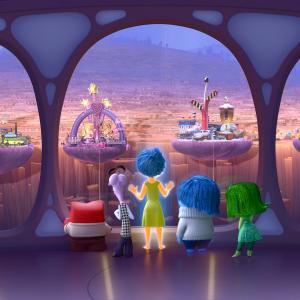
Image via Disney's 'Inside Out'
A mixture of thoughtful messaging and imaginative storytelling is what’s made many of Pixar’s films into modern classics. But the studio’s latest release, Inside Out, may include its most poignant theme yet: the complex emotional workings and unique roles of each and every human being.
Inside Out is a film that allows viewers to literally go inside the heads of its characters, and understand why they think the way they do. It’s a clever “what if” exercise, but also an opportunity to deeply explore the specific memories, assemblages of emotions, and detailed thoughts that make us special.
'Jurassic World' and the Problem with Hollywood Reboots
Among the big releases this summer, two films offer new installments of iconic franchises. One, Mad Max: Fury Road is a master class in how to do it right. Made as a labor of love, not a studio cash-grab, it uses a familiar setting and hero to explore new artistic territory, and still maintains an insanely entertaining level of action.
The other is Jurassic World.
'Good Kill' Aims Deep, But Only Skims Surface
Addressing moral injury in film is important. Addressing pertinent political issues like drone warfare is also important. But Good Kill doesn’t say anything an editorial wouldn’t, and takes about three times as long to say it. With this film, Andrew Niccol tries to create a sense of disassociation similar to what his drone pilot protagonist would feel. Sadly, the end isn’t compelling enough to justify the means. Good Kill ends up being a ponderous slog, a film that wants to be a conversation-starter but doesn’t introduce any new or interesting entry points into that conversation.
The Cheery Optimism of 'Tomorrowland'
It’s both ironic and appropriate that the new Disney film Tomorrowland is being released exactly a week after Mad Max: Fury Road. The new film from director Brad Bird (The Incredibles, The Iron Giant, Mission Impossible: Ghost Protocol) is the polar opposite of post-apocalyptic. It’s a film that’s hugely optimistic about the future, and our ability to fix the world’s problems through good old-fashioned ingenuity. The movie occasionally veers towards overly naïve, and its internal logic doesn’t always work. But despite some problems, it remains a refreshing alternative to a summer movie season that’s otherwise been filled with darker worldviews.
The film starts not with a jump forward, but backward, to the 1967 World’s Fair, where boy genius Frank Walker arrives with a homemade jetpack and hopes of winning an inventing competition. There Frank is befriended by a mysterious girl named Athena (Raffey Cassidy), who takes him to the magical world of Tomorrowland, a colorful futuristic place full of advanced discoveries and retro-space age design.
The Sneaky Progressivism of 'Mad Max: Fury Road'
But this isn’t just a movie about brooding wanderers and spectacular car crashes. The women of Fury Road are the ones who get most of the attention, and who are undeniably the heroes of the film. They are tough, and know how to take care of themselves, but also represent their world’s best hope for change. The film frequently juxtaposes the difference between their compassionate, renewal-focused instincts, and Immortan Joe’s destructive excess.
Whedon's 'Ultron:' Marvelous
From the first Avengers film, Whedon has shown that his primary interest, apart from the utter coolness of watching Hulk destroy a city block, is the dynamics of the Avengers team. This is a group of people with different backgrounds, ideologies, and agendas who might never have come together on their own. That they are forced to work together under impossible circumstances forces those tensions to their breaking point, but also creates a sense of camaraderie that’s thrilling to watch in action.
Working within the conventions of postmodern superheroism, Whedon also addresses the side effects of frequent exposure to violence. It might seem ironic that Captain America (Chris Evans), introduced as the ideal patriot, is one of the group’s more peace-loving members. But as the sole military veteran on the team, his outlook makes sense for someone who’s sacrificed a lot in battle. When he tells Stark, “Every time someone tries to end a war before it starts, innocent people die,” you know he speaks from experience.
'Ex Machina' is 'Frankenstein' for the Digital Age
The question of what makes us human has been around pretty much as long as we have. Attempts at tackling it have produced a veritable hall of fame of iconic results: Frankenstein. 2001: A Space Odyssey. The entire bibliographies of Philip K. Dick and Kurt Vonnegut. The list goes on.
But the thing about big unanswerable questions is that although we may never get closer to figuring out the answers, it can be awfully fun and rewarding to keep asking them. And with advances in society and technology, the question of our humanity — and its future — seems to transmogrify by the day.
In the grand legacy of stories about what separates us from the animals (or, in this case, androids), Ex Machina, the directorial debut of screenwriter-novelist Alex Garland (The Beach, 28 Days Later, Sunshine) is nothing new. It’s a direct descendent of Frankenstein, The Island of Doctor Moreau, and scads of stories that have come before, bringing up classic issues of nature, nurture, and what happens when we play God. But Garland’s sci-fi thriller smartly wears those influences on its sleeve, adding to them a sharply modern sense of style, with a plausible approach that’s both intriguing and troubling to consider.
Caleb (Domhnall Gleeson) is an employee at a large tech company, who wins a contest to hang out for a week with the company’s reclusive genius founder Nathan (Oscar Isaac) at his secluded house/research facility. Upon his arrival, Caleb discovers the real purpose of his visit: Nathan wants him to interact with Ava (Alicia Vikander), a robot he’s created, and determine whether she can convincingly pass for human. The conflict arises when Caleb’s true role in Nathan’s test, and Ava’s own mysterious intentions, come under suspicion. How much of Ava’s behavior is what Nathan has programmed into her, and how much is she acting on her own?
Writer-director Garland has always excelled in creating satisfying thrillers with deeper questions in mind, particularly in the realm of exploring uglier parts of human behavior. In Ex Machina, he may have created his best work yet, working with a very small cast in a limited space that gives the characters plenty of chances to turn on each other in subtle, clever ways.
'The Salt of the Earth:' Gorgeous Photos in Stark Perspective
Why do we engage with art? What is about a poem, painting, film, or photograph that can sometimes make them rank among the most impactful experiences of our lives? Sure, skill has a lot to do with it. Aesthetics and story do, too. But one of the things, perhaps the biggest thing that makes art art, and which gives it that extra emotional oomph, is perspective.
Perspective can mean many things. It can mean the point of view from which a story is told. It can mean the way in which something is presented visually; looking down from above, for example, or up from below. More expansively (and when it’s done well), perspective means using all of these to express the worldview of the artist, communicating their thoughts about a subject, or a place, or even just life in general, by what they choose to show us and how they choose to show it.
The Salt of the Earth, Oscar-nominated this year for Best Documentary, is a film about Brazilian photographer Sebastião Salgado. But it’s also a film about perspectives. Not just Salgado’s, shown through his life and his art, but also the perspectives of the film’s two directors, the photographer’s son, Juliano Ribeiro Salgado, and German New Wave auteur Wim Wenders (the director of Wings of Desire and Paris, Texas). Each man approaches the subject with a different point of view — Salgado recounting his own experiences, Juliano as the son who grew up with an often absent father, and Wenders as a fellow artist and long-time admirer of Salgado’s work.
'It Follows' Explores the Spirituality of Horror
Should Christians like horror movies?
It’s a question that many a Christ-following cinema junkie has had to ask themselves. It’s hard not to feel a bit conflicted enjoying a zombie apocalypse or a masked maniac when peace and tolerance are core parts of your belief system. If we’re going to be discerning consumers of culture, what value is there in horror?
I could pose one of a dozen different possible answers, each with their own set of arguments — for example, how the collective act of yelling in the dark at a dumb teen NOT TO GO IN THE CABIN transcends race, politics, and gender. Or how horror can help us embrace the inherently supernatural elements of faith. Or how it does the important job of reminding us that evil exists in the world, and can take on any number of forms.
But the argument that truly separates the wheat from the tares is that great horror, going all the way back to its roots in gothic literature, offers some of the best social commentary there is. Truly iconic horror films (and horror stories, for that matter) allow us to go below the surface of your basic spine-chiller, and think about everything from racism to gender politics to the afterlife.
Horror is at its best when it gives you something to think about along with your creeps. The new film It Follows, out this weekend, fits that bill quite well. It also happens to be one of the scariest movies this year.
The plot feels like classic urban legend. Teenager Jay (Maika Monroe) is dating the slightly older Hugh (Jake Weary), and decides one night to go all the way with him. Once it’s over, however, Hugh informs Jay that he’s cursed by a demon, a demon he’s now passed on to her. The demon will follow Jay, slowly and consistently, until it catches up with her and kills her, unless she first passes it on to someone else through sexual contact. If the demon kills her, it will then return to stalk and kill Hugh. Only Jay can see the demon, and it can look like anyone, be it a stranger, friend, or beloved family member.
This premise could easily be turned into something silly and gratuitous, and were it a studio venture instead of a smaller independent film, It Follows might have been just that. But although writer-director David Robert Mitchell has made a movie in which sex plays a pivotal role, he’s more interested in the consequences of it than the act itself. It Follows is packed with symbolism that represents loss of innocence, the onset of adulthood, and reminders of mortality — the ever-approaching darkness that none of us escape. Grim, yes, but also pretty impressive in a genre more commonly associated with objectification and cheap thrills.
